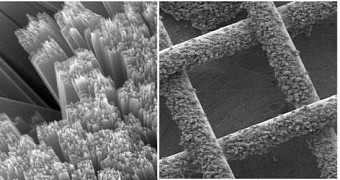Sunlight has always been the planet's cleanest and (closest to) inexhaustible energy source, so it always gives us the warm and fuzzies when we learn about even the slightest achievement in its area of research. As it happens, the latest breakthrough has given us a lot to (composedly of course) gush over.
Researchers from The Ohio State University have created a hybrid device that combines a solar cell with a battery, basically enabling the solar cell to store its own power.
Considering how tiny each solar cell is, this is a big achievement, especially since batteries need to be insulated from air completely.
Well, unless they're that awesome new Smart Window that doubles as a battery because of how air interacts with the materials making it up, but we digress.
The world's first solar battery
Batteries don't really store energy, just compounds and electrodes that produce a stream of electrons when contact is made between the plus and minus poles. Still, for the sake of simplicity we'll say they store energy.
Solar cells don't do that. They take in sunlight and convert it into energy, which has to be delivered to capacitors or whatever else is supposed to store it.
Now, though, solar cells have been given the ability to store their own energy, or at least a limited amount of it since they can, by nature, keep absorbing energy from the sun. It's like having a solar cell with emergency power.
The most obvious use for this is in solar-powered devices that can't fit many capacitors/batteries in their bodies, but would like to have some emergency power to use at night anyway.
What makes everything work
It all boils down to a mesh solar panel, which allows air to enter the battery, although this would not do anything without a special process that transfers electrons between the solar panel and the battery electrode.
Light and oxygen combine inside the device to allow the various chemical reactions that recharge the battery. You could say this eliminates the 20% loss of electrons that normally happens while they travel from the solar cell to an external battery.
The solar panel is made from titanium dioxide shaped in vertical rods (like grass blades) which lets air pass freely, even as the rods capture the sunlight. As for the battery, it manages to use just three electrodes instead of four: the mesh solar panel is one, a thin sheet of porous carbon is the second, and a lithium plate is the third. Layers of electrolyte are located in the spaces between the electrodes, and it is they that carry electrons to and fro.
Although, curiously enough, the charging ability is dependent on the mesh solar panel being coated in rust, of all things, since it needs to be red, making this a dye-sensitive solar cell (they tried other materials, but they didn't survive more than a few recharges).
There's a lot more science babble involved of course, but the bottom line is that the whole thing performs as advertised. Not sure when practical applications are expected though.

 14 DAY TRIAL //
14 DAY TRIAL //